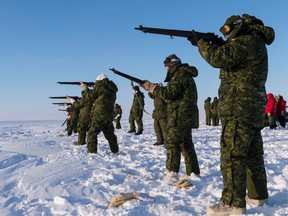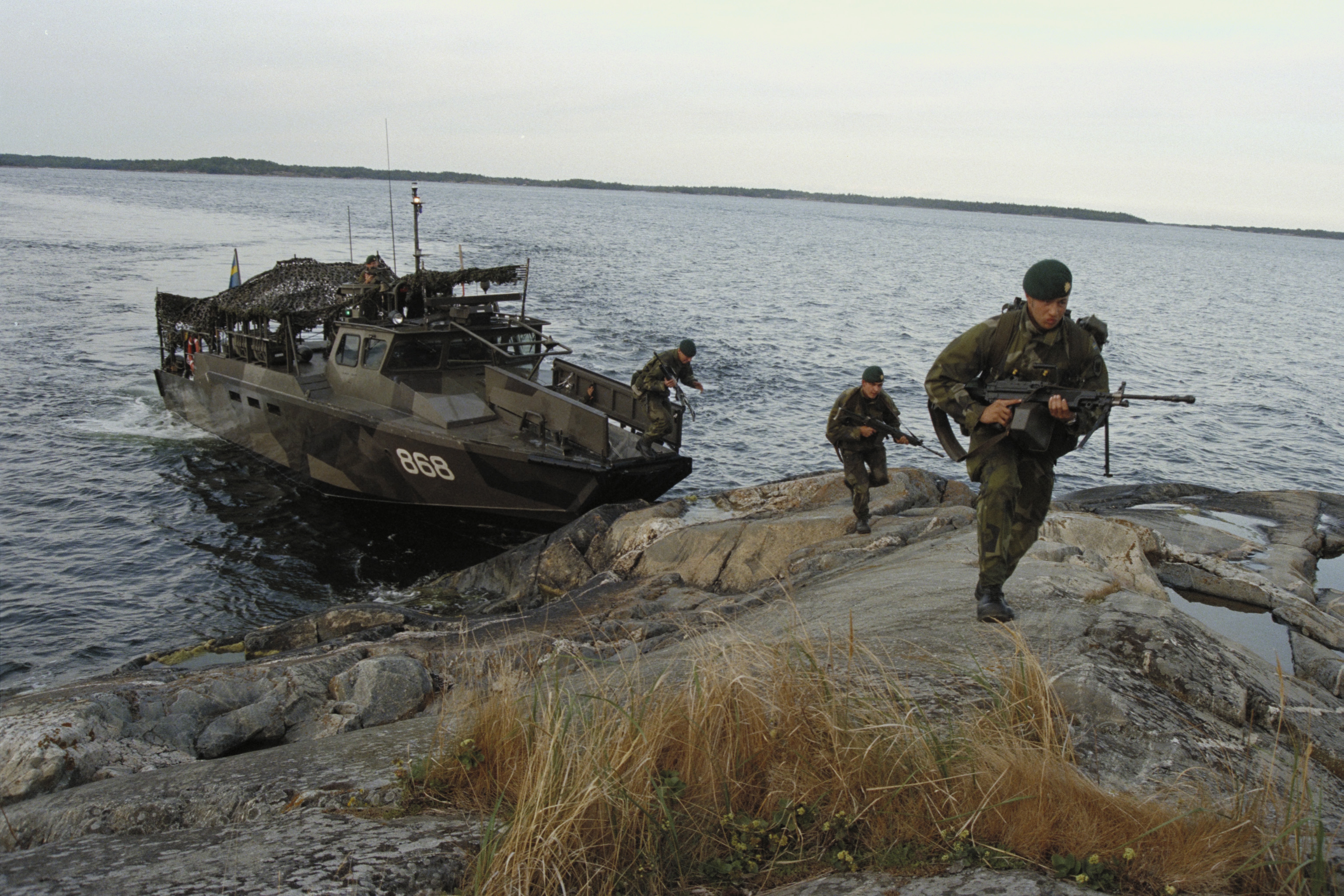- Reaction score
- 10,410
- Points
- 1,160
I found a great article in today's on-line National Post by an informed commentator and then went looking for a place to post it. It was then I discovered I couldn't find a thread devoted to the Arctic. We have discussed the Arctic fairly extensively but always in reference to something else: NORAD, NATO, Subs, F35s, Rangers, Light Brigades, Mobility, Joint Task Forces, Otters, Helicopters, Ports, AOPSs...... But we have never generated a focus on The Arctic.
Which kind of leads nicely into Greg Taylors commentary.
Which got me to thinking about the problems of the SSF and the Canadian Airborne Regiment in particular and why, if we do this thing again, then it would be better to train three CARs than one.
The CAR, IMO, was created as an economy of force effort. It was the least amount that the Canadian governments of the days and the various Canadian armies could do while covering the defence of Canada file, especially the defence of The Arctic. The lack of a clear and present danger, a clear and present threat resulted in what the French call cafard.
I can't remember if I was introduced to that word by Heinlein or Pournelle. Apparently it was a problem endemic in the Foreign Legion when troops were locked up in uneventful garrisons for too long. And "work is the only thing which will keep the cafard at bay".
The CAR spent too many years not doing its job because there was no job for it to do.
The solution has to be to keep the CAR 2.0 on constant rotation with the rest of the army. But the CAR is a light force and not an arrmoured force and with the best will in the world nobody seems to have been able to find soldiers that can fight in IFVs with Tanks one day and fall out of aeroplanes the next.
Guys that fall out of aeroplanes can cadge lifts from guys driving IFVs but that is not the same thing.
So if there is to be a CAR 2.0 then work needs to be found for them. In other words work needs to be found for Light Troops and that means having the Canadian government find jobs for Light Troops overseas and having the Canadian Army find the means to integrate the Light Troops into their overseas operations.
If CAR 2.0 is to be created and engaged then there will have to be at least three of them so that there will be one employed, one resting and one on alert.
But that would eat up a third of the infantry - a not insignificant portion. A whole brigade out of Canada's three.
That leaves two more to work with and to be supplied with various levels of armour and armament.
And the CAR 2.0 also needs to be able to put on an armoured exo-skeleton to expand its operational flexibility.
Can the rest of the army also adapt to drop its exo-skeleton if necessary?
Of course, all this is predicated on seeing a need for CAR 2.0 in the first place
Background info for Greg Taylor's piece
 publications.gc.ca
publications.gc.ca
North Warning System, 12 Nuclear subs, Special Service Brigade, Militia Vital Points troops (these days they would be GBAD heavy I believe), Bv206s and Bison APCs (thin skinned but easy to operate, all terrain and amphibious).
The Bvs are back on the horizon. The Bison are likely to be replaced by an armoured Silverado. And again we are talking about 12 subs.
Can we reset to 1984? And this time get Operation Brave Lion right?
 en.wikipedia.org
en.wikipedia.org
The Government found a job for light troops.....
Which kind of leads nicely into Greg Taylors commentary.
Greg Taylor served in the Canadian Army for 25 years, and was chief of staff of the Special Service Force from 1985 to 1987.
Greg Taylor: Can the army stand on guard in the arctic?
Control of land — Canadian land — actually requires soldiers on the land
Author of the article:
Greg Taylor, Special to National Post
Published Jul 09, 2023 • Last updated 7 hours ago • 4 minute read
213 Comments
File: Canadian soldiers near Hall Beach, Nunavut on February 25, 2017. Photo: Sgt Jean-François Lauzé, Task Force Imagery Technician.
Almost a year ago NATO Secretary General Jens Stoltenberg capped a visit to the air force base at Cold Lake, Alberta, by emphasizing Russian and Chinese military challenges to our Arctic. Russia for example has established a new Arctic command, which includes significant naval, air, army and special operations forces.It has also built new infrastructure such as Nagurskoye airbase, 500 kilometres closer to Canada’s strategic listening post at Alert than a less-capable Canadian base at Iqaluit. As for China, its 2018 Arctic policy paper declared it a “Near Arctic State,” and they will complete one of the world’s largest icebreakers in 2025, part of the Belt and Road Initiative to expand China’s reach world-wide.
Responding to challenges such as these, and pressure from our NATO allies, principally the United States, Canada has announced Arctic defence initiatives that focus almost exclusively on the air force and navy. This is understandable: historically the preferred way to control the vast Arctic land mass and seas has been by air and, when the ice melts sufficiently, by sea. The air force role became much more important during the Cold War, when Soviet bomber and missile attack over the North Pole loomed large, countered by extensive early warning radar and fighter interceptors. We shouldn’t be surprised then that our Arctic initiatives include over-the-horizon radar, F-35 fighters, surveillance aircraft, and ice-capable patrol ships. The cost of these initiatives is staggering: just one program, over-the-horizon radar, is conservatively estimated to cost $ 1 billion and will take years to implement.
How does our army fit into these initiatives? Historically the army has lagged behind the other services. In the early 1970s for example the army literally wandered around the Arctic in small groups of about 100 personnel, surviving harsh conditions in order to show the flag, soldiers on snowshoes pulling toboggans while Inuit drove by on snowmobiles. In the mid-1980s, the brigade in Petawawa responsible for defence of Canada developed a new concept for Arctic defence. Conventional wisdom, quoting the 18th century French writer Voltaire, was that no adversary wanted a “few acres of snow” in Canada.
There are however strategic targets in the Arctic — Alert for example — that an adversary might wish to destroy or seize. There is also a psychological target. During the Second World War almost one quarter of the army’s infantry remained on the West Coast defending against a possible Japanese invasion while, from D-Day until the war’s end, infantry units in Europe were begging for reinforcements. Today how many reinforcements would we send to Latvia if our own Arctic border was threatened?
Although Russia might be on its back foot today in Ukraine, and China has yet to demonstrate aggressive intentions, what might occur in five or 10 years if those countries act more forcefully to accomplish their Arctic ambitions? Russia has been active in Ukraine for at least 10 years, starting with seemingly low-level activities such as laying claim to territories on its border or encouraging dissatisfied populations. Could the same tactics be used in our Arctic? If they were, or if more hostile acts were undertaken, aircraft and ships are not the only military response, or even the best ones. Control of land — Canadian land — actually requires soldiers on the land.
The concept developed by the Petawawa-based Special Service Force in the mid-1980s included about 4,000 soldiers, one-third deployable virtually anywhere in the Arctic by parachute using Hercules strategic transport aircraft, two-thirds being transportable by heavy lift helicopters refuelled in the air to extend their range. Once on the ground, the entire Force would be very mobile, with state-of-the art Swedish-designed oversnow vehicles. The Force also included the entire range of army support capabilities, including, for example, combat engineers parachuting with heavy equipment such as bulldozers and graders to build a Hercules-capable airstrip on snow or ice.
This Force was a “fire brigade,” reacting anywhere to an adversary’s intrusion on Canadian soil, while army reserve units defended vital points — strategic targets, vital infrastructure, and two forward bases for the force at Yellowknife and Iqaluit. Unfortunately for various reasons this concept was never implemented.
Compare this force to the army’s current Arctic capability: four small companies, no more than 100 soldiers each, with limited oversnow capability. Most importantly, they cannot be delivered by parachute, having to land at an airfield in Canadian hands, the very airfields that would be among the first targets an adversary would seize.
There is an obvious gap between current capability and what was proposed in the mid-1980s. Given all the funding earmarked for air force and navy Arctic initiatives, some funds surely need to be found to improve our army’s capability to defend our Arctic, because in the final analysis it is our land — not just our skies and seas — that Canada must guard.
Which got me to thinking about the problems of the SSF and the Canadian Airborne Regiment in particular and why, if we do this thing again, then it would be better to train three CARs than one.
The CAR, IMO, was created as an economy of force effort. It was the least amount that the Canadian governments of the days and the various Canadian armies could do while covering the defence of Canada file, especially the defence of The Arctic. The lack of a clear and present danger, a clear and present threat resulted in what the French call cafard.
I can't remember if I was introduced to that word by Heinlein or Pournelle. Apparently it was a problem endemic in the Foreign Legion when troops were locked up in uneventful garrisons for too long. And "work is the only thing which will keep the cafard at bay".
The CAR spent too many years not doing its job because there was no job for it to do.
The solution has to be to keep the CAR 2.0 on constant rotation with the rest of the army. But the CAR is a light force and not an arrmoured force and with the best will in the world nobody seems to have been able to find soldiers that can fight in IFVs with Tanks one day and fall out of aeroplanes the next.
Guys that fall out of aeroplanes can cadge lifts from guys driving IFVs but that is not the same thing.
So if there is to be a CAR 2.0 then work needs to be found for them. In other words work needs to be found for Light Troops and that means having the Canadian government find jobs for Light Troops overseas and having the Canadian Army find the means to integrate the Light Troops into their overseas operations.
If CAR 2.0 is to be created and engaged then there will have to be at least three of them so that there will be one employed, one resting and one on alert.
But that would eat up a third of the infantry - a not insignificant portion. A whole brigade out of Canada's three.
That leaves two more to work with and to be supplied with various levels of armour and armament.
And the CAR 2.0 also needs to be able to put on an armoured exo-skeleton to expand its operational flexibility.
Can the rest of the army also adapt to drop its exo-skeleton if necessary?
Of course, all this is predicated on seeing a need for CAR 2.0 in the first place
Background info for Greg Taylor's piece
Challenge and commitment : a defence policy for Canada : D2-73/1987E-PDF - Government of Canada Publications - Canada.ca
Publication information / bibliographic Record.
North Warning System, 12 Nuclear subs, Special Service Brigade, Militia Vital Points troops (these days they would be GBAD heavy I believe), Bv206s and Bison APCs (thin skinned but easy to operate, all terrain and amphibious).
The Bvs are back on the horizon. The Bison are likely to be replaced by an armoured Silverado. And again we are talking about 12 subs.
Can we reset to 1984? And this time get Operation Brave Lion right?
Canadian Air-Sea Transportable Brigade Group - Wikipedia
Given the worrying outcome of BRAVE LION, Beatty suggested shifting the CAST force to Germany to create a single division-sized unit, along with their air squadrons and other supporting units.
Norwegian and other European politicians were dismayed by this move, and organized a meeting of MPs from across Europe to discuss it,[9] but to no avail.
Numerous commentators complained that the Canadian mission should have been reversed; instead of moving the brigade group to Germany, where it represented a limited amount of additional firepower, they argued that the German units should be shifted to Norway, where they would cause a significant change in the balance of power.[16] The Soviets normally had two divisions in the area; a full division of Canadian troops, on the defence, would represent a major military force. This point was made early by the Liberal defence critic, Doug Firth,[17] but these concerns were generally unheard given the outcry over the nuclear submarine issue.
CAST was first reduced in size and one of its battalions moved to the ACE Mobile Force (Land), which operated as a mobile reserve across the entire northern European area.[18] CAST ended its active role in 1987, and was formally disbanded in November 1989.[19]
The Government found a job for light troops.....












